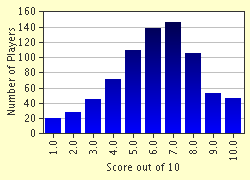Quiz Answer Key and Fun Facts
1. The first known computer virus was written in 1981 and was a forewarning of things to come. It was called 'Elk Cloner' and displayed a little rhyme on the screen, delivered by the floppy disks that contained the operating system. What type of computer was affected?
2. 1991 saw the 'Tequila' virus outbreak. It was the first virus that could change its signature (binary pattern) with each new replication in an attempt to escape detection from antivirus software. What's the term for this type of virus?
3. Which of the following applications would a macro virus most likely infect?
4. This self-replicating virus takes control of features on your computer that can transport files or information automatically. Most commonly they send out copies of themselves using your email address book. They can also open a backdoor into your computer for spammers and hackers. What's the generic term for this type of virus?
5. This sometimes malicious, irritating virus appears disguised as a gift, offer or update, with the sole intention to deceive you into approving its install. When the victim accepts the gift, a program is installed on your PC, which can then attack your files or alter configurations. Spyware falls under the banner of this pest. What's the generic term for this virus?
6. A famous virus was unleashed in 1991 and the resulting media frenzy put computer users into a panic (not to mention putting antivirus programs on the retail shelves). It was called 'Michelangelo' because it activated on the Renaissance painter's birth date of March 6th. What did this virus do?
7. This 2001 virus was the first to use social engineering to lure in the victim. It spread rapidly by masquerading as a digital picture of a celebrity and was named after the file supposedly on offer. What was this virus called?
8. This widespread 2004 virus utilised a vulnerability in Windows and spread through an open FTP port. It replicated by randomly targeting IP addresses. What's the common name for this virus?
9. "Look out, it's airborne!" OK, that's not a great analogy, but like its real-life counterpart, any single computer virus can come in many strains and can morph into an even more dangerous infection. Is it true that by 2004 there were close to 70,000 known computer viruses?
10. Nowadays, the target audience for virus authors is enormous with tens of millions of home and office PC's all networked together by the Internet. Fortunately we can protect ourselves against the majority of these attacks by running up-to-date antivirus software. Which of these major software publishers DOESN'T produce antivirus software?
Source: Author
Bertho
This quiz was reviewed by FunTrivia editor
crisw before going online.
Any errors found in FunTrivia content are routinely corrected through our feedback system.

